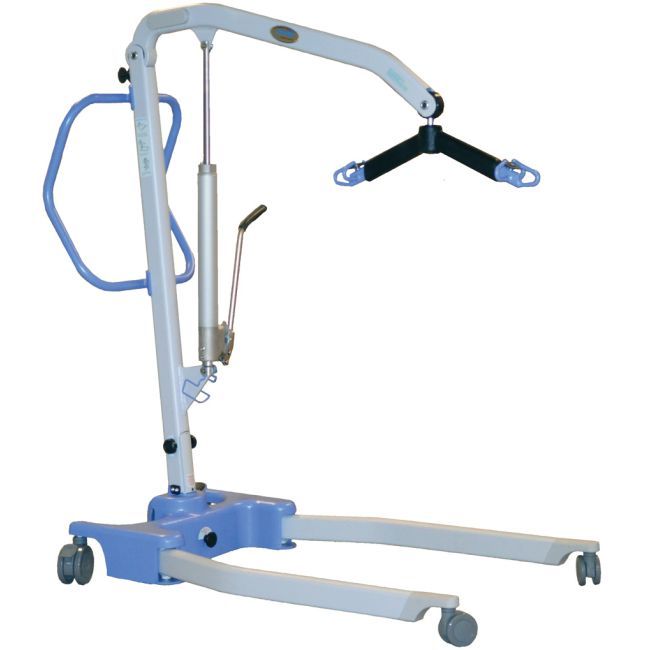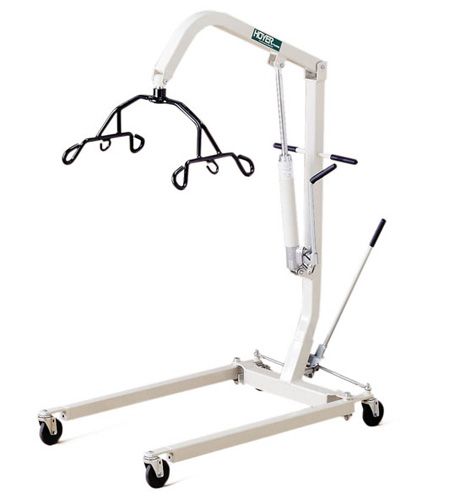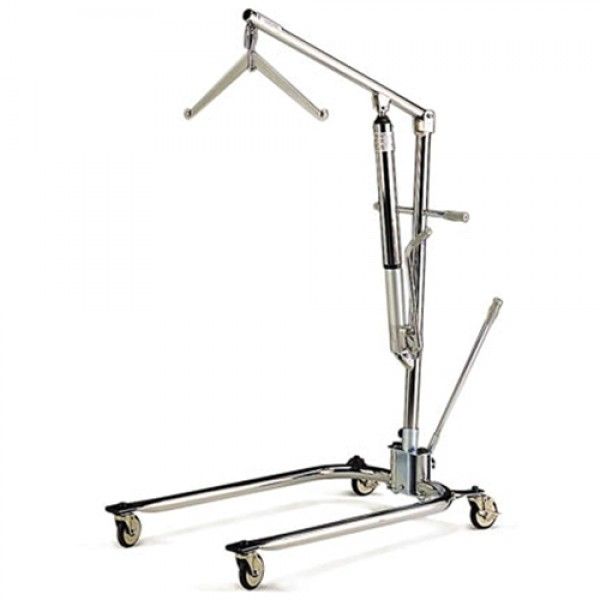 Written by Mike Price, OT
Written by Mike Price, OT
Hoyer Lifts are assistive medical devices which apply specially-designed slings and pads to safely lift a patient from a bed to a wheelchair, toilet, or stretcher.
These devices come in many shapes and sizes, and are often categorized by the level of automation they bear - manual/hydraulic, electric, or battery powered.
The most important feature of any device used for patient lifting is weight capacity.
While the majority of hoyer lifts are capable of lifting a variety of weight, this weight-bearing feature is crucial to ensuring the safest possible experience with the device.
Weight capacity should be checked before purchasing a lift for a bariatric patient, as not every Hoyer Lift is recommended for bariatric patients. Many manufacturers recommend purchasing an electric-powered lift for patients over a certain weight threshold to ensure caregivers do not injure themselves in the lifting process.
.jpg)
The general shape and design of a Hoyer Lift is as important as its weight capacity.
Some lifts are designed more for the purpose of raising a patient from a seated position directly upward, with minimal boom extension (see diagram above). These shorter-necked lifts also tend to be better at fitting through small doorways and around tight corners, making them ideal for in-home care.
Other lifts are longer, and use extended boom necks to reach to the center of wide beds, also making them better for bariatric patients.
Depending on the patient type and the amount of space available, the shape of a Hoyer Lift can influence its utility to the customer.
The operating power of your Hoyer Lift will play a large part in determining how your patient transfers are executed.
An electric or battery powered lift operates without the physical administration of the caregiver, raising and lowering at the touch of a button. While more convenient, these lifts are likely to cost more than a manual lift.
Manual hydraulic lifts require the administration of hand-cranking, meaning the caregiver must be able to generate enough counter-leverage by building lifting pressure manually. The caregiver must first position their patient within the lifting sling, then hand-crank the Hoyer Lift to a raised position before maneuvering the patient from point A to point B.
The front-facing, crane-like device to which the patient sling attaches to a lift is called the cradle. There are several common designs for cradles, but the most common difference between them is the number of attachment points they bear.
Cradles typically have two, four, or six attachment points.
Generally speaking, the more attachment points on a cradle, the larger the area of patient weight distribution becomes.
Depending on the patient’s specific needs, this can be a very important product decision. A six-point cradle will typically require less bending or movement from the patient than a two-point or four-point cradle will.
Hoyer Lifts come in a variety of materials, but most will either be constructed with a plastic blend or a dense metal blend (or sometimes, a combination of both!). Because of this, lifts tend to vary in product weight.
Although each product is constructed to be relatively lightweight, some are notably different in weight from others. This feature is notably influenced by the size of the lift as well.
The selection of Hoyer Lifts available from Rehabmart includes a multitude of styles, shapes, and additional product options.
Each of the high-quality products are produced by trusted and reliable medical equipment manufacturers such as Joerns and Medline. While no two Hoyer Lifts are identical, each product offers distinct advantages which make it ideal for the needs of specific patients. Our articles on the Best Bath Lifts and Best Pool Lifts also highlight a variety of specialized lifts that use similar technology to assist specific activities.
Here is a brief highlight of some of Rehabmart’s top-rated Hoyer Lifts, and their noteworthy advantages:

Joerns’ Hoyer Advance Patient Lift – One of the top-selling Hoyer Lifts from Rehabmart, this lift truly is top-of-the-line in all features. The Advance Patient Lift is made from a lightweight aluminum, which allows for easy operation by caregivers. It includes Push Pad assists which aid caregivers in initiating movement, thereby making moving even simpler. Additionally, its lightweight design does not sacrifice lifting ability, as it is capable of bearing up to 340 pounds with ease.

Joerns’ Hoyer Angular Designed Lifter with Six-Point Cradle – Another of Joerns’ effective and efficient products, this hoyer lift features a six-point cradle, which was noted earlier to be useful for providing a more comfortable lifting experience for the patient. Additionally, the lift bears an impressive 400-pound weight capacity and an adjustable U-base, allowing it to fit into tight spaces with ease.

Hydraulic Manual Hoyer Lift – A simple Hoyer Lift in appearance, this product provides the essential needs for most patients. Its 400-pound weight capacity, adjustable legs, and easy-to-store folding abilities set it apart from the competition. In addition to these abilities, the lift’s wide lifting range provides the ability to pick up patients from the floor and lift them up high enough to reach the vast majority of bed surfaces.
Hoyer Lifts are an essential safety tool to care for patients who are unable to get out of bed or move from their wheelchair without significant assistance.
Through the use of patient slings and adjustable lifting cradles, Hoyer Lifts carry a patient from nearly any surface and allow them to be moved to a stretcher, bathtub, toilet, or nearby location.
As was noted in the opening, Hoyer Lifts can be manual/hydraulic, electric, or battery powered. Hydraulic Hoyer Lifts make use of a pump or lifting crank, which is operated by the caregiver to raise the patient from their place of rest.
Electric and battery-powered lifts, on the other hand, use a wall outlet or battery, respectively, to mechanically lift the patient from bed.
Naturally, manual hydraulic Hoyer Lifts are more physically demanding of the caregiver. However, they are considerably more cost-effective than any other type of Hoyer Lift, as they do not require power.
This is also advantageous in the case of maintenance, because hydraulic Hoyer Lifts will never require the electrical upkeep that is needed for powered lifts.
Finally, caregivers do not need to worry in the case of electrical outages, as manual lifts require no electricity to operate.
Hoyer Lifts are a necessity for patients who are 90% - 100% incapable of getting out of bed without assistance. These patients can include the elderly, patients with leg injuries, paralyzed patients, incapacitated patients, and children with special needs.
Hoyer Lifts perform the crucial role of safely moving these patients from bed or place of rest while eliminating strain on the caregiver and also preventing falls due to lack of balance and muscle control.
Given the multitude of patient types for which these lifts are used, they come in a variety of shapes and sizes. Each lift bears different capabilities in weight capacity, size, cradle design, and more, in order to ensure each patient’s specific needs are met.
Hoyer Lifts are a cost-effective means to addressing a potentially dangerous situation. Physically moving patients when they are incapable of moving themselves leaves both caregivers and patients vulnerable to injury, and caregivers who do not use Hoyer Lifts when moving patients place themselves at high risk of injuring their back and arms.
Hoyer Lifts are critically important to safely transfer a patient from bed to locations such as a stretcher, a chair, or a bedside commode.
Therefore, whether you are the patient or the caregiver, a Hoyer Lift is essential for your safety and injury prevention.
Medicare Part B may cover some or the total amount of the cost of a Hoyer Lift, as it is classified under durable medical equipment (DME).
However, Medicare will likely require a doctor’s prescription for the lift before they will provide any coverage.
Every private insurance policy is different, and many private insurance policies follow the lead of Medicare. However, this is not always the case.
Before choosing to purchase a Hoyer Lift through private insurance, look into your policy to learn exactly what degree of coverage they offer. Checking your personal coverage regarding durable medical equipment (DME) will provide the clearest answer.
The purchase of a Hoyer Lift is a critical step towards safe and comfortable transfer of patients from surface to surface as well as protecting caregivers from injury. Rehabmart is here for you and your loved ones for each step of the process - whether researching the best product for your needs, or delivering it to your home.
We encourage you to look through Rehabmart’s catalogue of Hoyer Lifts to compare products, and find which one best suits your needs!
Want to learn even more? Find dozens of videos featuring products and caregiver tips like these at Rehabmart’s YouTube channel!

Co-Founder of Rehabmart and an Occupational Therapist since 1993. Mike has spent his professional career working in multiple areas of Occupational Therapy, including pediatrics, geriatrics, hand therapy, ergonomics and inpatient / outpatient rehabilitation. Mike enjoys writing articles that help people solve complex therapeutic problems and make better product choices.